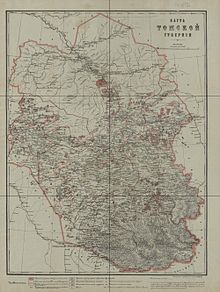Tomsk Governorate
The Tomsk Governorate ( Russian Томская губерния / Tomskaja gubernija ) was an administrative unit of the Russian Empire in Western Siberia . It comprised the upper and middle areas of the Ob River. It bordered in the extreme southeast of the Chinese Empire , within Russia the provinces of Yeniseisk and Tobolsk and the Oblast Semipalatinsk . It was much larger than today 's Tomsk Oblast and also roughly encompassed the territory of today 's Novosibirsk Oblast , the Altai Region , the Altai Republic , the Kemerovo Oblast and some areas in what is now Eastern Kazakhstan .
The area had 857,682 km², the capital was Tomsk .
The governorate was split off from Tobolsk in 1804, with whom it formed the general governorate of Western Siberia until 1882 . As early as 1783–1796 there was a Kolyvan governorate in the area . After the First World War , it was reduced in size several times by the formation of the Altai region (1917), the Omsk (1919) and Novo-Nikolayevsk (1921) governorates, and in 1925 it finally became part of the Siberia region .
Around 1900 it was divided into seven Ujesdy (circles):
statistics
The first all-Russian census of 1897 counted 1,927,679 inhabitants in the governorate. Most of them were Russians (1,658,041), there were also Minor Russians (Ukrainians) (99,300), Tatars or Altaians (95,196), Kazakhs, then called Kirghiz (24,643), Mordvins (14,702) and smaller groups. As everywhere in Siberia, the proportion of those deported was significant.
In the late 19th century, 24 million hectares were suitable for arable farming; Wheat, oats, rye, barley and potatoes were harvested. Cattle breeding was more important; In 1895 there were 1,440,611 horses, 1,261,146 cattle, 1,507,815 sheep and 268,098 pigs. There was fishing and the honey was collected in large quantities by wild bees. Gold, silver, lead, copper and cast iron were supplied by the Altai smelters in considerable quantities, although some deposits were exhausted at the end of the 19th century and production experienced a decline. At this time, the importance of hunting fur animals, which used to be almost the sole occupation of the natives, was also in decline. Among the industrial establishments there were primarily the smelting works, then distilleries, tanneries, breweries, tallow smelters, soap and light factories, brickworks and others, in total (1895) 7,570 with a production of 8,285,192 rubles.
Before the construction of the Trans-Siberian Railway , rivers were the most important transportation routes. After its completion, the traffic and population structure was placed on a completely new basis, which can be seen in the explosive growth of the city of Novo-Nikolayevsk (today's Novosibirsk).

